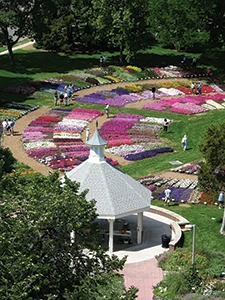
 Plant trialing is not a uniform process. It manifests in a multitude of ways across regions and even municipal lines, altering itself to test the climate and condition of the land. It can change with the temperamental winds, the gale force gusts that carry with them plunges in typical summer temperature (even providing unseasonal, overnight frosts), or the cotton-mouthed stretches that labor on without rain. Whole rows of crops can be consumed by ravaging pests or mildew diseases. Plant trialing is not homogenous and it is never boring. To manage plant trials is to change processes with the seasons.
Plant trialing is not a uniform process. It manifests in a multitude of ways across regions and even municipal lines, altering itself to test the climate and condition of the land. It can change with the temperamental winds, the gale force gusts that carry with them plunges in typical summer temperature (even providing unseasonal, overnight frosts), or the cotton-mouthed stretches that labor on without rain. Whole rows of crops can be consumed by ravaging pests or mildew diseases. Plant trialing is not homogenous and it is never boring. To manage plant trials is to change processes with the seasons.
For trial garden managers like Michigan State University’s Daedre Craig, the annual trial garden manager, and Colorado State University’s Jim Klett, an extension horticultural specialist, the process of maintaining a university’s gardens is a year-round affair. It requires diligent plant management, a standard treatment for plants within a variety, an in-depth planning process and the management of a hard-working, mostly volunteer-based crew.
Laura Robles, the research and development manager at Mast Young Plants, a private company in Michigan, often battles similar challenges; creating blind trial gardens, distinguishing them from display gardens, and developing an atmosphere of trialing and presentation similar to that of the California Sprint Trials.
Preparation
Many of the trials find their beginnings in rooted cuttings. Klett says that his facility begins receiving plugs or rooted cuttings in mid-March. All vegetative material is grown in campus greenhouses, where students can be heavily involved in the growth process (a great learning experience for young horticulturalists). The varieties are then moved outdoors in early May for planting. This year, Colorado State featured about 1,100 varieties from 25 different companies. The CSU gardens also feature a “two winters, three growing seasons” perennials trials, with about 200 varieties.
 For Craig and Robles, the process is similar. Some companies send Craig seeds, which are started in the Michigan State greenhouses before being moved outdoors. For Robles, the display gardens are started from cuttings; the trial gardens are started from a combination of cutting and seed. Mast Young also occasionally uses plugs or liners, depending on the trial being performed.
For Craig and Robles, the process is similar. Some companies send Craig seeds, which are started in the Michigan State greenhouses before being moved outdoors. For Robles, the display gardens are started from cuttings; the trial gardens are started from a combination of cutting and seed. Mast Young also occasionally uses plugs or liners, depending on the trial being performed.
The trials require a uniform treatment of the various varieties. Craig was careful to note that if a plant is showing distress her staff is instructed not to “baby it.” Instead, they record the degradation and note it in their plant reviews, which are sent back to the breeders. Each of the Michigan State plants receives the same supplemental lighting (when in the greenhouse), the same watering (if needed), and the same fertilizer treatment (a 19-4-23, 125 ppm N mix). The only two exceptions to that treatment are MSU’s calibrachoas and petunias, both of which have struggled with yellowing/chlorosis. To combat that, Craig employs Jack’s Petunia Feed Plus Magnesium, 20-3-19, on those two genuses, allowing them to maintain a low media pH and prevent iron and magnesium deficiency.
Klett’s team at Colorado State University faces slightly different challenges in Colorado. Their display gardens are the second biggest tourist attraction in Fort Collins, Colo. And Klett estimates they attract between 40,000 and 60,000 people annually and are open year-round; making the trial beds difficult to fumigate. To provide a healthy growing environment Klett’s team uses ZeroTol in the beds and will sparingly use insecticides or fungicides in the case of a large-scale outbreak.
“As far as fertility goes, we incorporate a slow-release fertilizer with a 14-14-14 analysis and we have been liquid feeding (the plants) twice a week through the irrigation system, with a 20-10-20 type of fertilizer,” Klett says. At Mast Young Plants, Robles says, they try to replicate the plant’s potential growing environment as much as possible. This can mean adjusting the growing situation for container space or for landscape situations.
“For our early spring, pre-intro trials we propagate with our regular young plant production and split the trials up according to light and mist needs as much as possible,” she says. “Then the trials are all transplanted and finished in the trial area where the temperatures are maintained at around a 72 ADT (Average Daily Temperature).”
Mast Young also runs night interruption lighting but nothing else “special” is done for the trials.
Maintenance and Evaluation
Maintaining the trial gardens requires dedicated effort from a concentrated group of workers. Each season brings varied challenges, mostly weather-related. Klett’s Colorado State team has been dealing with afternoon thunderstorms, the first of their kind in three decades, he says. Craig and Robles have been grappling with unseasonably cool temperatures and excess rain.
Making weather adjustments can mean watering more frequently or feeding more heavily during cooler months to get things growing.
“This has been an unusual summer for us in terms of weather, so we have to keep in mind that plant performance may be atypical as well,” Robles says.
She notes that having schizophrenic weather conditions is actually a benefit for the trials,
“A large part of our customer base is in the Midwest,” says Robles, “so for us to know how these plants perform here is extremely beneficial.”
Craig, whose gardens are also located in Michigan, echoed Robles’ sentiments. “We’re one of the largest floriculture states in the country and it’s important to know how plants are going to perform locally.”
For Klett, in Colorado, trialing is also hugely important. “Our climate is so unique here,” he says. “We have high-light density and low-humidity, (with trialing) we’re able to learn which plants are going to perform the best.”
Evolution
One of the growing trends in trial gardens is the use of containers.
All three of the trial managers noted that container trials have increased in recent years, possibly as a reflection of the expanding popularity of small space gardening.
Craig says she even had to order an additional 75 containers for this year’s trials, bringing MSU’s total to 190.
Robles also notes a vested consumer interest in container trailing, “We have definitely seen an increase in containers. A big part of our display garden is devoted to combinations that we grow in deco pots and other containers, primarily due to customer interest.”
Chris Mosby is assistant editor of Greenhouse Management.
One for all
National Plant Trial Database gains momentum.
By Joe Jancsurak
 Plant trialing, to say the least, can be a confusing exercise. Protocols and scoring procedures can vary from one trial location to another. And making sense of it all is difficult, albeit critical. (See “Trialing and Tribulations,” page 10)
Plant trialing, to say the least, can be a confusing exercise. Protocols and scoring procedures can vary from one trial location to another. And making sense of it all is difficult, albeit critical. (See “Trialing and Tribulations,” page 10)
That’s changing as breeders and trial grounds get on board with the Web-based National Plant Trials Database, launched two years ago by All-America Selections (AAS). Currently 28 sites and nine major breeders are participating. According to AAS Executive Director Diane Blazek, in 2013, the 12 participating trial grounds rated almost 2,500 varieties with more than 9,400 ratings in total.
“The database is meant to serve as a single source – a repository for data from participating flower trials throughout North America” says Blazek. “The breeders wanted this because trial grounds scoring and procedures can be inconsistent; so we established a set of standardized scoring procedures and trialing protocol. We’re using a 1-5 point system and clear guidelines about watering, pinching, feeding, etc. We’re doing our part to raise the bar and help trial sites become better at what they do. Many are already there.”
 Easy access gains great reviews
Easy access gains great reviews
Participating trial sites are asked to populate the datbase with information from the plants being trialed at their locations. Among those who appreciate having a centralized database on his tablet is Steven Poppe, a horticulture scientist at the University of Minnesota West Central Research and Outreach Center.
“It requires some time up front to upload the information,” says Poppe, “but from there it’s convenient to continuing updating and monitoring trial data. In addition, once you enter the data in the Excel spreadsheet on your tablet, it’s done. This eliminates the extra work required when you have to transfer hand-written information on a data sheet to another report.”
Bernadette Clark, bedding plants trials coordinator, at the JC Raulston Arboretum at North Carolina State University, says she’s “thrilled to be a part of the National Plant Trials effort, largely because the data can be looked at anywhere, anytime, and that’s what you want – easy access.”
Bob Croft, technical support manager at Sakata, predicts that “as the database information is eventually made available to landscapers and home gardeners, and it’s publicized more, then more of the smaller breeders will be willing to pay the initiation and usage fees and to be a part of it.”
Kerry Meyer, project manager at Proven Winners says the right metrics were chosen for the database and as new trials are added, this will create “more impetus” for the remaining trial sites to join.
“If efforts continue to make the uploading of information easy,” says Meyer, “then this has the potential to really grow.”
Susan Schmitz, trials and education manager at Ball Horticulural Company, concurs. “We feel the National Plant Trial Database is a great opportunity to quickly locate performance data of new varieties on one website, and to easily share that data within our organization at Ball and with others in the industry. The ability to compare a particular variety’s performance, at one glance, in Florida, Georgia, North Carolina, and Texas as well as Colorado, Ohio, Pennsylvania, and Minnesota, for example, is incredibly helpful to breeders, our marketing staff, and our customer service department.”
Schmitz says one improvement to the database could possibly come in the form of having most data available on the www.planttrials.org website by a certain date, rather than having to come back to the site multiple times to monitor updates.
For now, though, the database is proving to be a useful and appreciated tool for its 300 users. And while it’s limited to vegetative and seed, next year, Blazek says, perennials will become part of it, and edibles will be added later.
“As with any idea in its infancy stage, we anticipate that this concept will continue to grow, change, and become more robust. Right now, the trialing requirements are pretty basic and we’re depending on the participants to direct us on improvements and enhancements they want to see made.”
Participating trial sites
|
Joe Jancsurak is editor of Greenhouse Management.

Explore the September 2014 Issue
Check out more from this issue and find your next story to read.
Latest from Greenhouse Management
- CEA Alliance celebrates bipartisan introduction of Supporting Innovation in Agriculture Act
- Dümmen Orange North America celebrating 25th anniversary in 2025
- Illinois Landscape Contractors Association changes name to Landscape Illinois
- 2025 Proven Winners Horticulture Scholarship applications now open
- ICL’s Gemini Granular herbicide now registered for use in California
- Eurazeo Planetary Boundaries Fund acquires Bioline AgroSciences
- Spring Meadow Nursery's Freedom Shelley finds joy in plants
- Leading Women of Horticulture: Dana Massey, Plantworks Nursery






